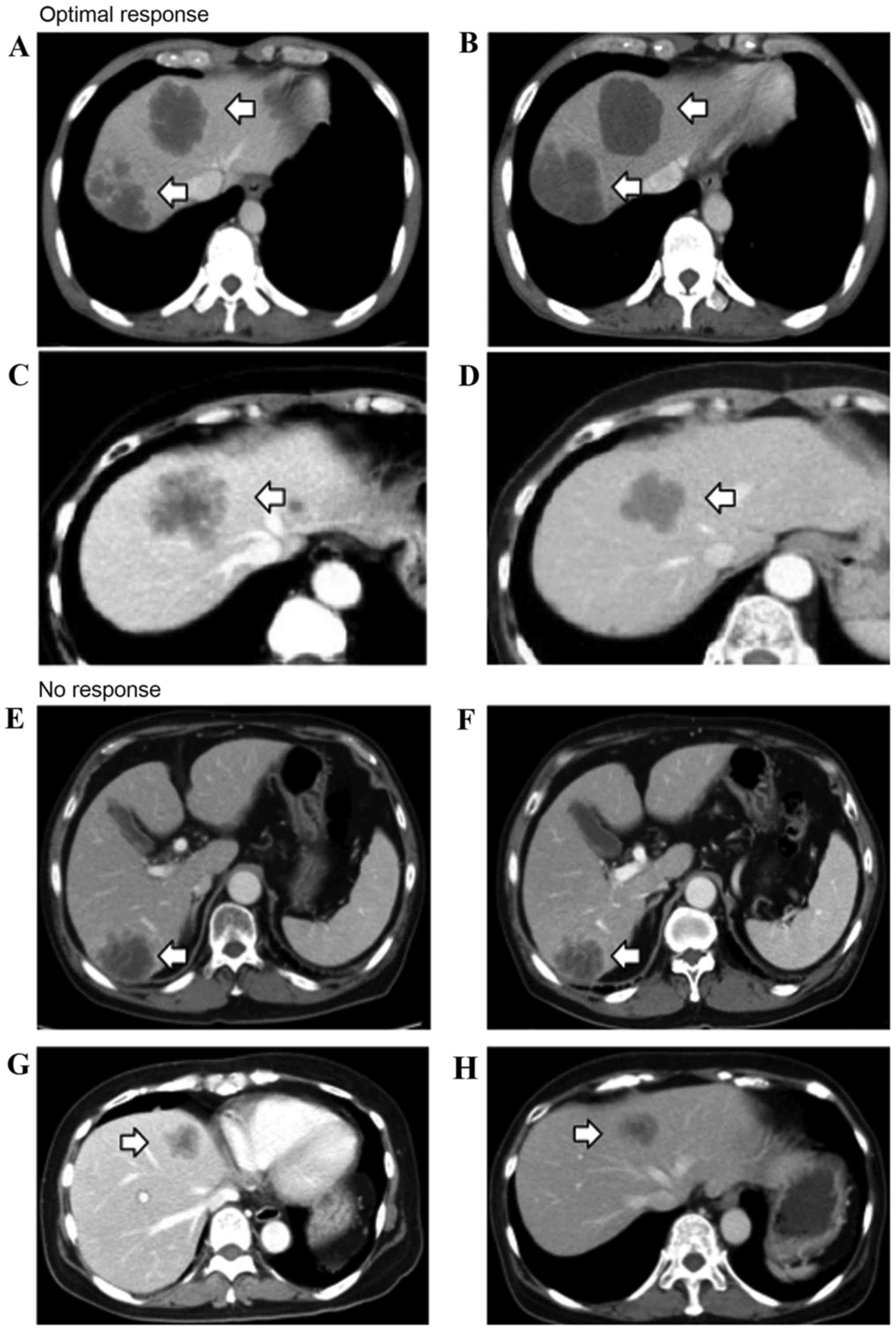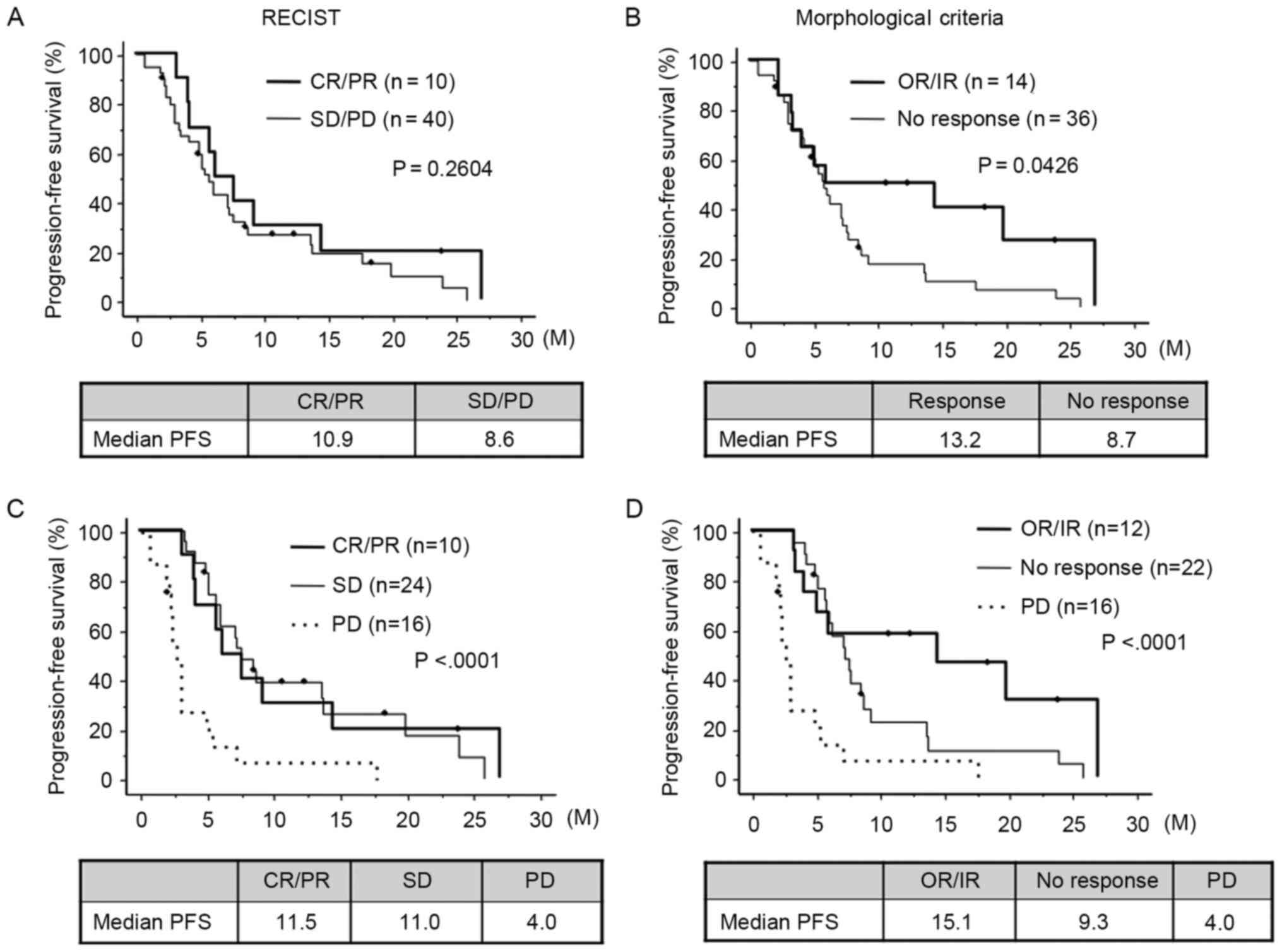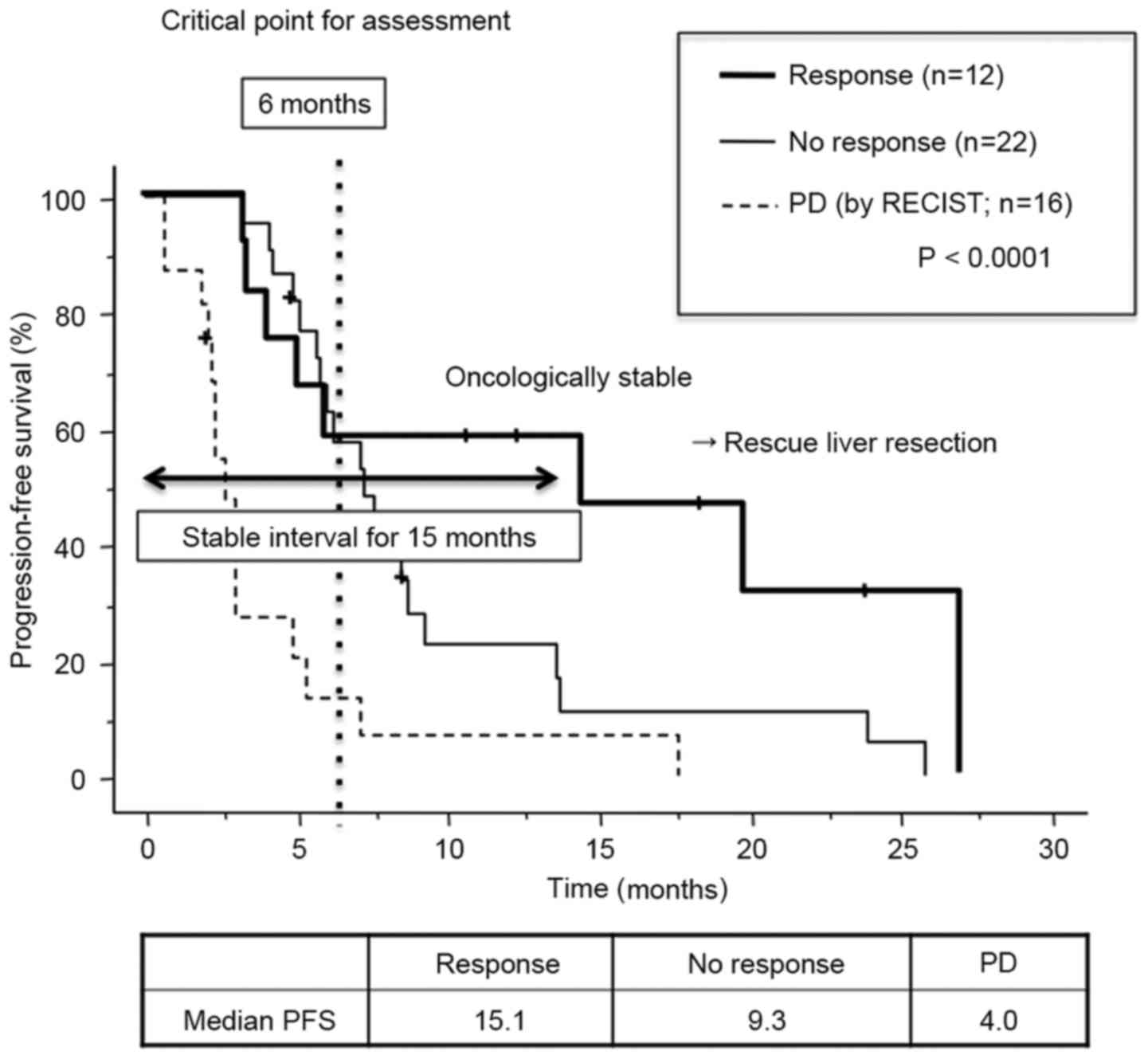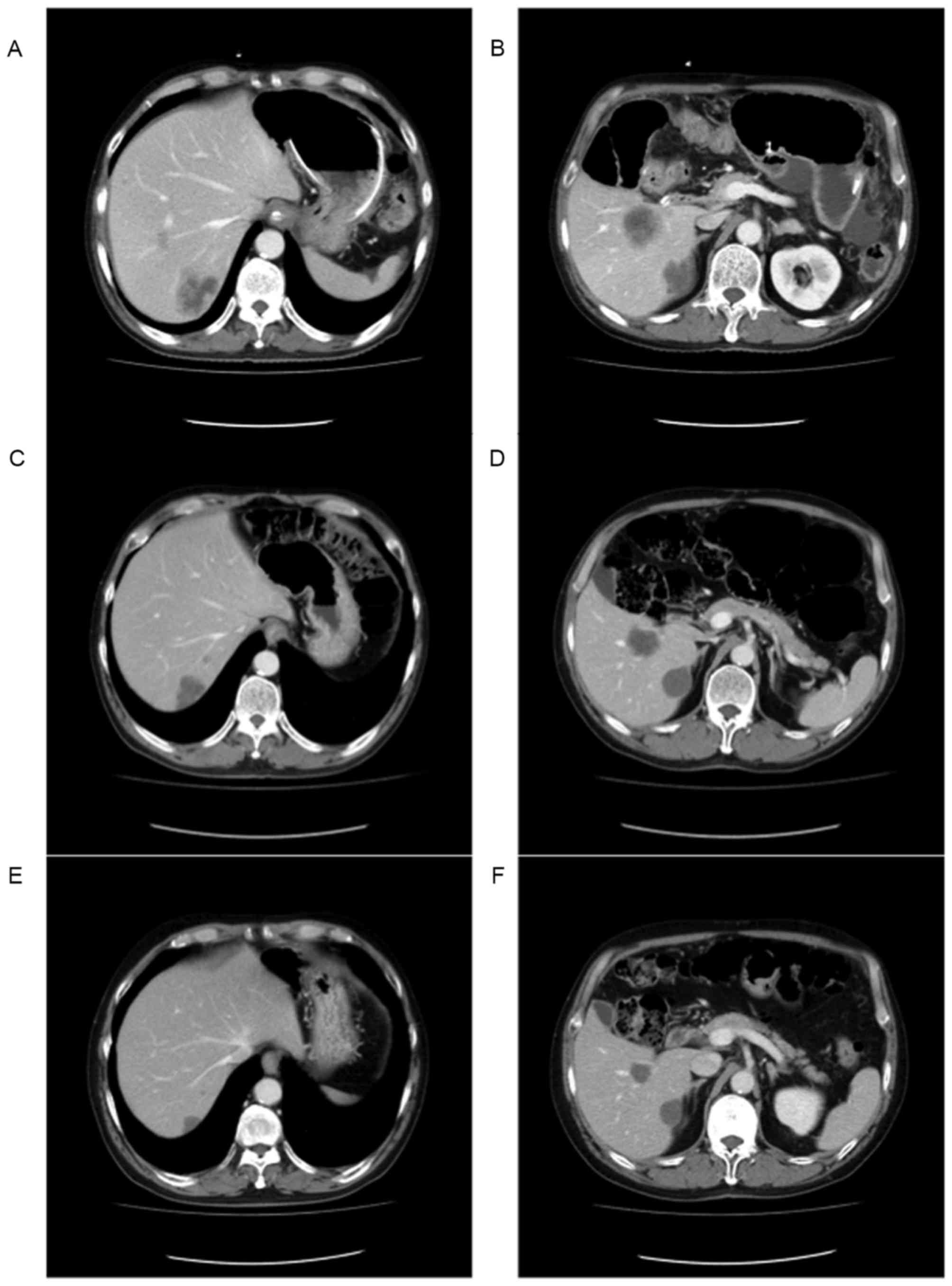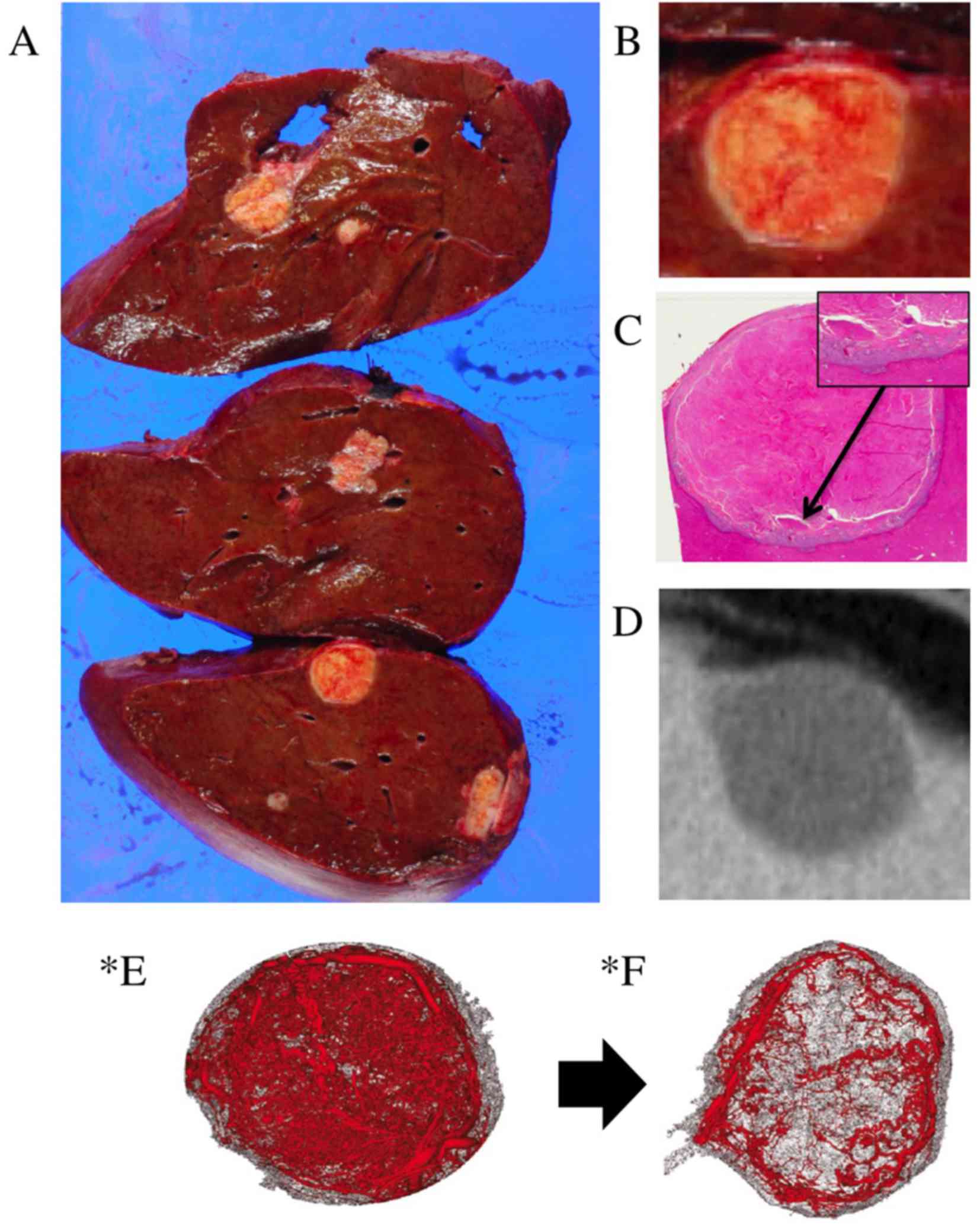Morphological response contributes to patient selection for rescue liver resection in chemotherapy patients with initially un-resectable colorectal liver metastasis
- Authors:
- Published online on: June 7, 2017 https://doi.org/10.3892/ol.2017.6338
- Pages: 1491-1499
-
Copyright: © Suzuki et al. This is an open access article distributed under the terms of Creative Commons Attribution License.
Abstract
Introduction
Recent improvements in chemotherapy, including the use of biological agents, have been shown to prolong the survival of patients with metastatic colorectal cancer (mCRC), with a recorded median overall survival time of 30 months (1,2). For patients with mCRC and liver metastasis, liver resection combined with systemic therapies resulted in a 5-year survival rate of 25–40% (3). Combination regimens using various biological agents with cytotoxic chemotherapy achieved high response rates and a reduced tumor size (4). This enables liver resection for mCRC patients with borderline resectable, as well as un-resectable, liver metastasis.
Tumor response to chemotherapy is the initial step in the selection of patients who are most likely to benefit from surgery. Changes in the characteristics of liver metastases may be assessed with respect to surgical and oncological viewpoints. In addition to the technical considerations, the ability of the tumor to be resected and its biology are the most important factors that determine the outcome of the patients. Candidates for tumor resection of liver metastases should have surgically resectable masses and be oncologically stable. The patients should also be unlikely to relapse within a short period of time following surgery (5–11).
The Response Evaluation Criteria in Solid Tumors (RECIST) model is widely used to evaluate tumor response, however, since its introduction, there has been increasing concern regarding the use of traditional tumor response criteria (12,13). This is due to RECIST being limited in its application in assessing the response of tumors to biological agents that exhibit a cytostatic mechanism of action. For patients with metastatic gastrointestinal stromal tumors, RECIST using anatomical information only (such as tumor size), has been shown to significantly underestimate the initial tumor response to imatinib (14). This is since patients that exhibit a stable response to imatinib have a similar outcome to those who achieve a complete response (CR) or partial response (PR) when evaluated using RECIST (15). Several studies have shown that morphological response is an improved alternative to RECIST for predicting the outcome of patients with colorectal liver metastases (16–18). However, the potential clinical application of morphological evaluation has not been attempted for the selection of patients most likely to benefit from surgery. The present study examined whether evaluations that included morphological criteria were useful in selecting the best therapeutic strategy for patient treatment.
Patients and methods
Patients
A total of 50 patients with mCRC and unresectable liver metastasis were recruited for the present retrospective study. The patients had histologically confirmed and measurable mCRC. Each patient underwent oxaliplatin-based chemotherapy, with or without bevacizumab, between May 2008 and November 2012 at the Saitama Medical Center (Jichi Medical University, Saitama, Japan). The present study was approved by the Research Ethics Committee of Jichi Medical University.
Imaging analysis
Tumor morphology was assessed using enhanced computed tomography (CT) and characterized according to the criteria previously described (16): Group 1, homogeneous low attenuation with a thin, sharply-defined tumor-liver interface; group 3, heterogeneous attenuation with a thick, poorly-defined tumor-liver interface; and group 2, intermediate morphology that could be rated as either group 1 or 3. A change in morphology between group 3 or 2 to group 1 was defined as an optimal response (OR; Fig. 1), and a group 3 to group 2 change was defined as an incomplete response (IR). The absence of marked changes in tumor morphology was defined as no response (NR; Fig. 1). In patients with multiple tumors, morphological response was assigned based on changes observed in the majority of the tumors. Response to chemotherapy was also determined using RECIST.
Statistical analysis
Fisher's exact test was used to examine the association between two categorical variables. Continuous comparison of the variables between two groups was performed. Unpaired t-tests were used for those variables that followed a normal distribution, and the non-parametric Mann-Whitney-Wilcoxon test was used for those variables that did not follow a normal distribution. P<0.05 was considered to indicate a statistically significant difference. Values are shown as the mean ± standard error. Progression-free survival (PFS) and overall survival (OS) data were plotted as Kaplan-Meier curves, and the differences among the groups were compared using a log-rank test.
Results
Characteristics of patients
The present study included 34 men and 16 women with a median age of 65 years (range, 45–83 years). A total of 28 patients presented with primary colon tumors, while the other 22 patients were diagnosed with tumors of the rectum. Liver metastasis was detected simultaneously in 34 patients and metachronously in 16 patients. Solitary liver metastases were observed in 19 patients and multiple metastases were observed in 31 patients. A total of 30 patients presented with metastasis in extrahepatic regions, including 10 in the lymph nodes, 9 in the lung, 5 in the intra-peritoneum, 2 in the bone, 2 in the pelvic node at the anastomotic site, one in the spleen and one in the ovarian. The size of the largest metastasis ranged from 9 to 140 mm, with a median size of 47 mm. All patients underwent oxaliplatin-based chemotherapy with or without bevacizumab as the first line of treatment. The treatment regimens were mFOLFOX6 in 15 patients, which included 200 mg/m2 folinic acid, 400 mg/m2 5-FU and 85 mg/m2 oxaliplatin on day 1, followed by 46 h of continuous infusion with 2,400 mg/m2 5-FU on days 1 and 2 and XELOX in the remaining 35 patients, which consisted of 2,000 mg/m2 capecitabine on days 1–15) and 130 mg/m2 oxaliplatin on day 1. A total of 19 patients were also treated with bevacizumab, anti-vascular endothelial growth factor (VEGF) antibody: For one patient treated with mFOLFOX6 regimen, 5 mg/kg bevacizumab was administrated on day 1 and q14d, and for 18 patients treated with XELOX regimen, 7.5 mg/kg bevacizumab was administrated on day 1 and q21d.
Morphological response rate
The morphological response rate following treatment with or without bevacizumab is shown in Table I. There were 14 responders (28.0%), including 7 patients with an OR (14.0%) and 7 patients with an IR (14.0%). A total of 36 patients (72.0%) showed NR. The rate of patients classified as OR/IR who were treated with bevacizumab was 47.4% (9/19), whereas for patients who did not receive bevacizumab, the rate was 19.4% (6/31).
CT evaluations according to RECIST and morphological criteria
Using RECIST, 10 patients had a CR/PR, 27 had stable disease (SD) and 13 had progressive disease (PD). No significant difference was observed in PFS time between those patients who were classified as CR/PR and those patients who had SD/PD (10.9 months for CR/PR vs. 8.6 months for SD/PD; P=0.2604; Fig. 2A). According to the morphological criteria, 14 patients were classified as having OR/IR, while 36 patients had NR. PFS time for patients showing OR/IR was significantly improved when compared with patients showing NR (13.2 months for OR/IR vs. 8.7 months for NR; P=0.0426; Fig. 2B). For those patients who showed PD, they also had a short PFS period (4.0 months; n=16) compared with the SD and CR/PR groups (P<0.0001). Therefore, these patients were classified as group 1 and used as a comparison to patients in the other groups using RECIST and morphological criteria. The RECIST criteria did not show any significant difference in PFS time between patients with CR/PR and SD (11.5 months for CR/PR vs. 11.0 months for SD; Fig. 2C). Morphological criteria, however, revealed an increase in the difference in PFS time between those patients with OR/IR and those with NR (15.1 months for OR/IR vs. 9.3 months for NR; P<0.0001; Fig. 2D). Among those patients who had SD, those treated with bevacizumab had improved median PFS times compared with those who did not receive bevacizumab (13.1 months for bevacizumab and chemotherapy vs. 10.0 months for chemotherapy alone; P=0.3415). This indicated that bevacizumab may exhibit an antitumor effect that does not result in a reduction in tumor size or morphological criteria. Comparison of the survival curves between the OR/IR and NR groups showed that they remained close to each other up to 6 months after chemotherapy (the second period of CT evaluation), but the curves then diverged from each other subsequent to this date. The median PFS was >15 months for patients classified as having an OR or IR. These results indicated that tumors in patients showing OR/IR AT 6 months' post-treatment were oncologically stable, which would make the patients candidates for surgical intervention, including rescue liver resection (Fig. 3).
Univariate analysis
Univariate analysis revealed that morphological response was the only significant prognostic factor for PFS following chemotherapy (Table II), therefore multivariate analysis was not carried out.
Table II.Univariate analysis concerning the prediction of progression free survival in the 50 patients. |
Representative optimal response case
A 60-year-old man presented with CRC and unresectable liver metastasis. The CT images shown in Fig. 4A and B indicate that the patient had multiple liver metastases. The tumors appeared to exhibit heterogeneous attenuation with a thick, poorly-defined tumor-liver interface, which placed the patient in group 3, based on the morphological criteria. The patient was subsequently treated with mFOLFOX6 and bevacizumab, including 200 mg/m2 folinic acid, 400 mg/m2 5-FU and 85 mg/m2 oxaliplatin on day 1 and 5 mg/kg bevacizumab on day 1 and q14d, followed by 46 h of continuous infusion with 2,400 mg/m2 5-FU on days 1 and 2, following resection of the ascending colon. After 2 months, the tumors in the liver had changed to become classified as homogeneous low attenuation masses with a thin, sharply-defined tumor-liver interface, which now placed the patient in group 1 (Fig. 4C and D). At the same time, the liver tumors demonstrated an OR; however, during the study, tumors that were OR were not classified as being oncologically stable and resectable, and as such, the patient continued receiving chemotherapy. At 16 months post-chemotherapy, the size of tumors were reduced (Fig. 4E and F) and showed no accumulation on positron emission tomography-CT (data not shown), therefore, a resection of the liver tumors was performed. Fig. 5A-C show the pathological features of the tumor, which consisted of necrosis, granulation and fibrosis, with a clear borderline between the tumor tissue and the non-tumor tissue. Fig. 5D shows the radiological imaging of the tumor with morphological response, which may have been a result of pathological change induced by bevacizumab. While the tumor exhibited a major response according to the tumor regression grade (19), it was revealed to possess living tumor cells at the edge of the necrotic tissue. The living tumor cells were distributed in a way that was consistent with the area of vascular reconstruction of a mouse xenograft model induced by the anti-vascular endothelial growth factor (VEGF) antibody (Fig. 5E and F) in a previous study (20). Therefore, the pathological change may have been a result of the antitumor effect of the bevacizumab that the patient received.
Discussion
The present study demonstrated that patients with mCRC with liver metastasis showing OR/IR within 6 months of chemotherapy were oncologically stable, which made the patients candidates for rescue liver resection. Assessment of the morphological response contributed to the selection of the therapeutic strategy, which included surgical intervention for patients with mCRC who underwent chemotherapy for their initially unresectable tumors.
Assessment of morphological response has been reported to be a good predictor of therapeutic outcomes for patients undergoing chemotherapy (16–18,21,22), whereas conventional size-based criteria, such as RECIST, may be limited in assessing the response of the patient to biological agents that exhibit a cytostatic mechanism of action. The present data revealed that the prognostic advantage of an optimal morphological response of patients with mCRC undergoing chemotherapy with bevacizumab was consistent with results of previous studies (16–18). Furthermore, the present study provides evidence for the clinical application of morphological criteria in selecting the therapeutic strategy for those patients who most likely benefit from surgery.
Advances in combination chemotherapy with biological agents have improved the response rates of patients and may reduce the size of tumors (4). This allows liver resection of patients with mCRC with borderline resectable, as well as unresectable, liver metastasis. In the present study, chemotherapy was used to treat the primary tumor prior to its resection, which was then followed by a hepatectomy.
The limitation of this strategy includes the lack of a clear definition of what constitutes a resectable liver tumor (3). Technical considerations pertaining to the resectability of the tumors may be overcome when there is a reduction in the size of the tumor, although oncological concerns may remain. Several guidelines produced by the European Society for Medical Oncology (23) and the National Comprehensive Cancer Network (24) outline the management of patients with mCRC and liver metastasis. While these guidelines take into account the number, location and distribution of the liver tumors, there is no consensus on how to apply these characteristics to determine whether surgery is indicated. Patient candidates for liver resection are those unlikely to relapse within a short time period following surgery; that is, the patients must possess oncologically stable tumors. The present study was conducted to examine whether morphological criteria are useful in the selection of patients with oncologically stable tumors. The present data shows that the patients who had an OR/IR presented with stable disease and a median PFS period of 15.1 months. As such, they may be classified as potential candidates for rescue liver resection.
While the decision for resection is clear for patients with an OR/IR, those patients whose tumors had a complete response following chemotherapy should also be considered. Benoist et al (25) reported that persistent macroscopic or microscopic residual disease, or early recurrence in situ, was observed in 55 (83%) of 66 liver metastases that were classified as having a CR on imaging. Therefore, resectable tumors should be treated with surgical intervention while they can be identified on imaging. The majority of patients who showed a morphological response in the present study were classified at the first or second assessment using CT 3–6 months after chemotherapy. The 6-month point is important, as it is the time when a decision is made on whether surgical intervention for rescue liver resection is appropriate for a patient.
The morphological criteria was first reported in 2009 as a novel surrogate marker for the prognosis of patients with mCRC undergoing chemotherapy, including bevacizumab (16), and was later validated surgically (18) and medically (26) in treated populations. The reasons behind why the morphological response has a predictive value for prognosis in patients treated with bevacizumab should also be considered. It has been reported that the pathological response induced by bevacizumab is associated with patient OS (19). A change in morphology, as determined by CT imaging, includes vascular reconstruction, which is believed to be a response to treatment with bevacizumab. By comparison with the pathological and morphological features of the tumor of the representative optimal response case in the present study, living tumor cells were revealed to be distributed within a vascular reconstruction area that was induced by an anti-VEGF antibody in a previous study (20). From the present study, it was revealed that morphological response correctly predicted the pathological change produced by the antitumor effect of bevacizumab, which meant that it had predictive value in the prognosis of the patients treated with bevacizumab.
Although the definition of resectable liver metastases has changed, it has been estimated that 20–30% of patients with liver metastases are potential candidates for liver resection (27,28). Recent phase III trials have shown that the increased use of liver resection as a treatment option has significantly impacted the survival of the CRC population (1,2). The liver resection rate in more recent phase III trials has been between 10 and 14% for patients who underwent liver resection (1,29). This means that 10–16% of patients with mCRC remained excluded from surgical treatment. For these patients, the loss of opportunity to be considered for liver resection means they may become candidates for rescue liver resection by assessment of their morphological response.
In conclusion, the present findings provided evidence for physicians to consider previously un-resectable mCRC patients as candidates for surgical treatment. However, it is important to interpret the present results within the context of the study limitations, such as retrospective analysis and selected population, and additional studies may be undertaken prior to definitive guidelines for their clinical application being made.
Acknowledgements
The present study was supported in part by a grant-in-aid awarded to the post graduate students from Jichi Medical University, a grant-in-aid from the Ministry of Education, Culture, Sports, Science and Technology (grant no. JP16K10514), and the JKA Foundation through its promotion funds from the Keirin Race (grant no. 27-1-068).
References
|
Venook AP, Niedzwiecki D, Lenz HJ, Innocenti F, Mahoney MR, O'Neil BH, Shaw JE, Polite BN, Hochster HS, Atkins JN, et al: CALGB/SWOG 80405: Phase III trial of irinotecan/5-FU/leucovorin (FOLFIRI) or oxaliplatin/5-FU/leucovorin (mFOLFOX6) with bevacizumab (BV) or cetuximab (CET) for patients (pts) with KRAS wild-type (wt) untreated metastatic adenocarcinoma of the colon or rectum (MCRC). J Clin Oncol. 32 Suppl:52014. View Article : Google Scholar : PubMed/NCBI | |
|
Heinemann V, von Weikersthal LF, Decker T, Kiani A, Vehling-Kaiser U, Al-Batran SE, Heintges T, Lerchenmüller C, Kahl C, Seipelt G, et al: FOLFIRI plus cetuximab versus FOLFIRI plus bevacizumab as first-line treatment for patients with metastatic colorectal cancer (FIRE-3): A randomised, open-label, phase 3 trial. Lancet Oncol. 15:1065–1075. 2014. View Article : Google Scholar : PubMed/NCBI | |
|
Siriwardena AK, Mason JM, Mullamitha S, Hancock HC and Jegatheeswaran S: Management of colorectal cancer presenting with synchronous liver metastases. Nat Rev Clin Oncol. 11:446–459. 2014. View Article : Google Scholar : PubMed/NCBI | |
|
Kopetz S, Chang GJ, Overman MJ, Eng C, Sargent DJ, Larson DW, Grothey A, Vauthey JN, Nagorney DM and McWilliams RR: Improved survival in metastatic colorectal cancer is associated with adoption of hepatic resection and improved chemotherapy. J Clin Oncol. 27:3677–3683. 2009. View Article : Google Scholar : PubMed/NCBI | |
|
Fong Y, Fortner J, Sun RL, Brennan MF and Blumgart LH: Clinical score for predicting recurrence after hepatic resection for metastatic colorectal cancer: Analysis of 1001 consecutive cases. Ann Surg. 230:3093211999. View Article : Google Scholar | |
|
Gayowski TJ, Iwatsuki S, Madariaga JR, Selby R, Todo S, Irish W and Starzl TE: Experience in hepatic resection for metastatic colorectal cancer: Analysis of clinical and pathologic risk factors. Surgery. 116:703–711. 1994.PubMed/NCBI | |
|
Kato T, Yasui K, Hirai T, Kanemitsu Y, Mori T, Sugihara K, Mochizuki H and Yamamoto J: Therapeutic results for hepatic metastasis of colorectal cancer with special reference to effectiveness of hepatectomy: Analysis of prognostic factors for 763 cases recorded at 18 institutions. Dis Colon Rectum 46 (10 Suppl). 1–31. 2003. | |
|
Nordlinger B, Guiguet M, Vaillant JC, Balladur P, Boudjema K, Bachellier P and Jaeck D: Surgical resection of colorectal carcinoma metastases to the liver. A prognostic scoring system to improve case selection, based on 1568 patients. Association Française de Chirurgie. Cancer. 77:1254–1262. 1996. View Article : Google Scholar : PubMed/NCBI | |
|
Viganò L, Capussotti L, Majno P, Toso C, Ferrero A, De Rosa G, Rubbia-Brandt L and Mentha G: Liver resection in patients with eight or more colorectal liver metastases. Br J Surg. 102:92–101. 2015. View Article : Google Scholar : PubMed/NCBI | |
|
Wei AC, Greig PD, Grant D, Taylor B, Langer B and Gallinger S: Survival after hepatic resection for colorectal metastases: A 10-year experience. Ann Surg Oncol. 13:668–676. 2006. View Article : Google Scholar : PubMed/NCBI | |
|
Yi JH, Kim H, Jung M, Shin SJ, Choi JS, Choi GH, Baik SH, Min BS, Kim NK and Ahn JB: Prognostic factors for disease-free survival after preoperative chemotherapy followed by curative resection in patients with colorectal cancer harboring hepatic metastasis: A single-institute, retrospective analysis in Asia. Oncology. 85:283–289. 2013. View Article : Google Scholar : PubMed/NCBI | |
|
Antoch G, Kanja J, Bauer S, Kuehl H, Renzing-Koehler K, Schuette J, Bockisch A, Debatin JF and Freudenberg LS: Comparison of PET, CT, and dual-modality PET/CT imaging for monitoring of imatinib (STI571) therapy in patients with gastrointestinal stromal tumors. J Nucl Med. 45:357–365. 2004.PubMed/NCBI | |
|
Stroobants S, Goeminne J, Seegers M, Dimitrijevic S, Dupont P, Nuyts J, Martens M, Van den Borne B, Cole P, Sciot R, et al: 18FDG-Positron emission tomography for the early prediction of response in advanced soft tissue sarcoma treated with imatinib mesylate (Glivec). Eur J Cancer. 39:2012–2020. 2003. View Article : Google Scholar : PubMed/NCBI | |
|
Blanke CD, Demetri GD, von Mehren M, Heinrich MC, Eisenberg B, Fletcher JA, Corless CL, Fletcher CD, Roberts PJ, Heinz D, et al: Long-term results from a randomized phase II trial of standard-versus higher-dose imatinib mesylate for patients with unresectable or metastatic gastrointestinal stromal tumors expressing KIT. J Clin Oncol. 26:620–625. 2008. View Article : Google Scholar : PubMed/NCBI | |
|
Therasse P, Arbuck SG, Eisenhauer EA, Wanders J, Kaplan RS, Rubinstein L, Verweij J, Van Glabbeke M, van Oosterom AT, Christian MC, et al: New guidelines to evaluate the response to treatment in solid tumors. european organization for research and treatment of cancer, national cancer institute of the United States, national cancer institute of Canada. J Natl Cancer Inst. 92:205–216. 2000. View Article : Google Scholar | |
|
Chun YS, Vauthey JN, Boonsirikamchai P, Maru DM, Kopetz S, Palavecino M, Curley SA, Abdalla EK, Kaur H, Charnsangavej C and Loyer EM: Association of computed tomography morphologic criteria with pathologic response and survival in patients treated with bevacizumab for colorectal liver metastases. Jama. 302:2338–2344. 2009. View Article : Google Scholar : PubMed/NCBI | |
|
Nishioka Y, Shindoh J, Yoshioka R, Gonoi W, Abe H, Okura N, Yoshida S, Oba M, Hashimoto M, Watanabe G, et al: Radiological morphology of colorectal liver metastases after preoperative chemotherapy predicts tumor viability and postoperative outcomes. J Gastrointest Surg. 19:1653–1661. 2015. View Article : Google Scholar : PubMed/NCBI | |
|
Shindoh J, Loyer EM, Kopetz S, Boonsirikamchai P, Maru DM, Chun YS, Zimmitti G, Curley SA, Charnsangavej C, Aloia TA and Vauthey JN: Optimal morphologic response to preoperative chemotherapy: An alternate outcome end point before resection of hepatic colorectal metastases. J Clin Oncol. 30:4566–4572. 2012. View Article : Google Scholar : PubMed/NCBI | |
|
Klinger M, Tamandl D, Eipeldauer S, Hacker S, Herberger B, Kaczirek K, Dorfmeister M, Gruenberger B and Gruenberger T: Bevacizumab improves pathological response of colorectal cancer liver metastases treated with XELOX/FOLFOX. Ann Surg Oncol. 17:2059–2065. 2010. View Article : Google Scholar : PubMed/NCBI | |
|
O'Connor JP, Carano RA, Clamp AR, Ross J, Ho CC, Jackson A, Parker GJ, Rose CJ, Peale FV, Friesenhahn M, et al: Quantifying antivascular effects of monoclonal antibodies to vascular endothelial growth factor: Insights from imaging. Clin Cancer Res. 15:6674–6682. 2009. View Article : Google Scholar : PubMed/NCBI | |
|
Choi H, Charnsangavej C, Faria SC, Macapinlac HA, Burgess MA, Patel SR, Chen LL, Podoloff DA and Benjamin RS: Correlation of computed tomography and positron emission tomography in patients with metastatic gastrointestinal stromal tumor treated at a single institution with imatinib mesylate: Proposal of new computed tomography response criteria. J Clin Oncol. 25:1753–1759. 2007. View Article : Google Scholar : PubMed/NCBI | |
|
Shindoh J, Chun YS, Loyer EM and Vauthey JN: Non-size-based response criteria to preoperative chemotherapy in patients with colorectal liver metastases: The morphologic response criteria. Curr Colorectal Cancer Rep. 9:198–202. 2013. View Article : Google Scholar : PubMed/NCBI | |
|
Schmoll HJ, Van Cutsem E, Stein A, Valentini V, Glimelius B, Haustermans K, Nordlinger B, van de Velde CJ, Balmana J, Regula J, et al: ESMO consensus guidelines for management of patients with colon and rectal cancer. a personalized approach to clinical decision making. Ann Oncol. 23:2479–2516. 2012. View Article : Google Scholar : PubMed/NCBI | |
|
NCCN Clinical Practice Guidelines in Oncology: Colon Cancer. http://www.nccn.org/professionals/physician_gls/f_guidelines.aspJanuary 1–2016 | |
|
Benoist S, Brouquet A, Penna C, Julié C, El Hajjam M, Chagnon S, Mitry E, Rougier P and Nordlinger B: Complete response of colorectal liver metastases after chemotherapy: Does it mean cure? J Clin Oncol. 24:3939–3945. 2006. View Article : Google Scholar : PubMed/NCBI | |
|
Yoshita H, Hosokawa A, Ueda A, Ando T, Kajiura S, Kato H, Kawabe H, Tomizawa G, Horikawa N, Yabuhita K, et al: Predictive value of optimal morphologic response to first-line chemotherapy in patients with colorectal liver metastases. Digestion. 89:pp. 43–48. 2014; View Article : Google Scholar : PubMed/NCBI | |
|
Garden OJ, Rees M, Poston GJ, Mirza D, Saunders M, Ledermann J, Primrose JN and Parks RW: Guidelines for resection of colorectal cancer liver metastases. Gut. 55 Suppl 3:iii1–8. 2006. View Article : Google Scholar : PubMed/NCBI | |
|
Stangl R, Altendorf-Hofmann A, Charnley RM and Scheele J: Factors influencing the natural history of colorectal liver metastases. Lancet. 343:1405–1410. 1994. View Article : Google Scholar : PubMed/NCBI | |
|
Schwartzberg LS, Rivera F, Karthaus M, Fasola G, Canon JL, Hecht JR, Yu H, Oliner KS and Go WY: PEAK: A randomized, multicenter phase II study of panitumumab plus modified fluorouracil, leucovorin and oxaliplatin (mFOLFOX6) or bevacizumab plus mFOLFOX6 in patients with previously untreated, unresectable, wild-type KRAS exon 2 metastatic colorectal cancer. J Clin Oncol. 32:2240–2247. 2014. View Article : Google Scholar : PubMed/NCBI |



